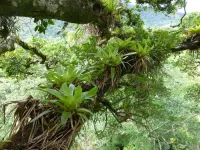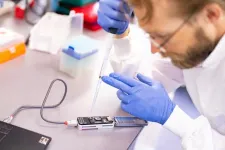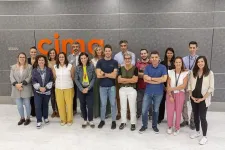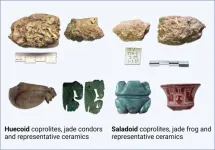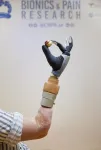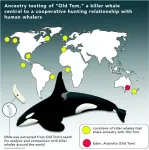(Press-News.org) Orchids, mosses, ferns—or epiphytes, defined as nonparasitic plants that grow on other plants—are crucial for Earth’s biodiversity and play essential roles in forests around the world, building habitat in trees for myriad other life forms, from bacteria and insects to birds and reptiles.
However, the very attributes that have enabled epiphytes to thrive in forest canopies are now making them vulnerable to both natural and human-caused disturbances, according to Nalini Nadkarni, the University of Utah biologist renowned for her pioneering work studying and conserving treetop ecosystems.
In a study published this month, Nadkarni found these vital plants are under more and more pressure as a result of rapid environmental change, and proposes specific actions for preserving these fascinating plants.
“This synthesis revealed the exceptional vulnerability to the increasing levels of disturbances—such as climate change and deforestation—on the abundance diversity and connectivity of canopy-dwelling plants around the globe,” she said. “Although we categorize the disturbances with greatest negative effects on canopy plants as ‘natural,’ as hurricanes and wildfire, human activities are increasing the severity and frequency of those in the USA and around the world.”
Nadkarni’s latest paper reviews the available science on epiphyte communities and categorizes the drivers and consequences of and societal responses to drought, wind, insects, wildfire, logging and other disturbances. Her findings should serve as a wake-up call to land managers and others interested in preserving the health of the world’s woodlands.
“Across all impacts, disturbance agents were significantly more likely to lead to negative, rather than positive, effects in both tropical and temperate locales,” Nadkarni wrote in the paper posted Oct. 11 in the journal New Phytologist. The study examined 255 previous papers on ecological disturbances impacting epiphytes in 58 countries.
Nadkarni’s explorations in forest canopies have inspired a generation of naturalists, drawing scientific attention to habitats that are only now becoming well understood. And epiphytes are the main attraction.
“Communities of plants that live in rainforest canopies—ferns, orchids and bromeliads—play ‘keystone roles’ in maintaining biodiversity, fostering critical interactions for pollination and seed dispersal and maintaining healthy nutrient cycles, even though their biomass is small relative to whole forests,” she said. “Many of them have been cultivated by people for centuries because of their beauty and the ways they connect us to aesthetically and spiritually to nature.”
Epiphytes display an astonishing array of diversity, with 28,000 known species. Mosses are the most prevalent kind.
“They don’t have roots that go into trunks or to the forest floor, but rather it is their leaves that are adapted to intercept the dissolved nutrients that come to them in the form of mist and fog,” Nadkarni said in an impassioned 2009 TED talk.
“Underneath these live epiphytes, as they die and decompose, they actually construct an arboreal soil…They have a tremendous capacity for holding onto nutrients and water,” she continued. “If you pull back on those mats of epiphytes, what you’ll find underneath them are connections, networks of what we call canopy roots. These are not epiphyte roots. These are roots that emerged from the trunks and branches of the host trees themselves. And so those epiphytes are actually paying the landlord a bit of rent in exchange for being supported high above the forest floor.”
Her new review found that forest fragmentation was the most frequently cited disturbance agent, followed by climate change, epiphyte harvesting, extreme events, agriculture, hurricanes and forestry activities.
“Surprisingly, relative to human disturbances (e.g., deforestation, forest fragmentation), natural disturbances (e.g., hurricanes, floods, wildfire) were more likely to lead to negative effects on epiphytes,” the paper reported. To reduce harm to epiphytes, land managers should take specific actions, such as keeping large, old trees in forestry operations, clearing only small areas to harvest epiphytes and protecting large sections of forests. They should also use epiphytes as indicators to determine how healthy an environment is and involve local communities in forest management.
In the future, Nadkarni concluded, it’s crucial to share these findings with policymakers and land managers, so we can work together to protect epiphytes and the valuable roles they play in our forests.
Nadkarni’s review, titled “Complex consequences of disturbance on canopy plant communities of world forests: a review and synthesis,” appears in the November 2023 edition of New Phytologist. Her work is funded by the National Science Foundation. Additional support came from NSF’s Integrative Organismal Systems program and the National Geographic Society.
New Phytologist is an international journal focusing on high-quality, original research across the broad spectrum of plant sciences, from intracellular processes through to global environmental change. The journal is owned by the New Phytologist Foundation, a not-for-profit organization dedicated to the promotion of plant science.
END
Epiphytes, amazing plants like moss and bromeliads found in trees, face growing threats
University of Utah biologist Nalini Nadkarni has devoted her career to shedding light on habitats in forest canopies, where epiphytes play a 'keystone role.'
2023-10-11
ELSE PRESS RELEASES FROM THIS DATE:
AI speeds up identification brain tumor type
2023-10-11
What type of brain tumor does this patient have? AI technology helps to determine this as early as during surgery, within 1.5 hours. This process normally takes a week. The new technology allows neurosurgeons to adjust their surgical strategies on the spot. Today, researchers from UMC Utrecht and researchers, pathologists and neurosurgeons from the Princess Máxima Center for pediatric oncology and Amsterdam UMC have published about this study in Nature.
Every year, 1,400 adults and 150 children are diagnosed with a tumor in the brain or spinal cord in the Netherlands. Surgery is often the ...
A new way to erase quantum computer errors
2023-10-11
Quantum computers of the future hold promise in solving all sorts of problems. For example, they could lead to more sustainable materials, new medicines, and even crack the hardest problems in fundamental physics. But compared to classical computers in use today, rudimentary quantum computers are more prone to errors. Wouldn't it be nice if researchers could just take out a special quantum eraser and get rid of the mistakes?
Reporting in the journal Nature, a group of researchers led by Caltech is among the first to demonstrate a type of quantum eraser. The physicists show that they can pinpoint and correct for mistakes in quantum computing ...
Blocking an immune molecule reduces tumor growth and prolongs survival in animal models of the most aggressive childhood cancer
2023-10-11
Researchers from Cima and the Clínica Universidad de Navarra, together with the international cooperative group Diffuse Midline Glioma (DMG-ACT), have confirmed that blocking an immune checkpoint molecule reduces the tumor and prolongs survival in animal models of the most aggressive childhood cancer. This research, carried out at the Cancer Center Clínica Universidad de Navarra, shows that inhibition of TIM-3 promotes the immune memory of diffuse intrinsic stem glioma (DIPG) and improves the prognosis of the disease.
DIPG is an aggressive brain stem tumor and the leading cause of death related to pediatric cancer. Due to its location therapeutic ...
Mummified poop reveals pre-Columbian cultures of the Caribbean consumed a diversity of plants, with peanuts, papaya, maize, and even cotton and tobacco detected
2023-10-11
DNA analysis of mummified poop reveals two pre-Columbian Caribbean cultures ate a wide variety of plants, like maize, sweet potato, and peanuts—and tobacco and cotton traces were detected too, according to a study published October 11, 2023 in the open-access journal PLOS ONE by Jelissa Reynoso-García from the University of Puerto Rico, Puerto Rico, and colleagues.
Mummified poop, or coprolites, can reveal clues to diet and lifestyle. In this study, Reynoso-García and colleagues analyzed plant DNA isolated from coprolites sampled from archeological sites of two pre-Columbian cultures (Huecoid and Saladoid) to see what these peoples ate ...
Risk factors for dementia vary by ethnicity, study finds
2023-10-11
Modifiable risk factors—including hypertension, obesity, diabetes, low HDL cholesterol and sleep disorders—confer a higher risk of dementia for people in some minority ethnic groups compared to White people, according to a new study published this week in the open-access journal PLOS ONE by Naaheed Mukadam of University College London, UK, and colleagues.
The number of people with dementia is on the rise around the world. There has been increasing interest in potentially modifiable risk factors, ...
Study links selfies to higher ratings of slimness
2023-10-11
In a new study, participants tended to rate women’s bodies as slimmer when viewed in selfie photographs than in photographs taken from other angles. Ruth Knight of York St John University, UK, and Catherine Preston of the University of York, UK, present these findings in the open-access journal PLOS ONE on October 11.
Popular on social media, selfies are portraits taken by the photo’s subject, who positions the camera away from their body but pointed back at themself. Prior research has suggested that viewing selfies might affect viewers’ judgments of the photo subjects’ attractiveness and could, in some cases, lead to ...
Groundbreaking achievement as bionic hand merges with user’s nervous and skeletal systems, remaining functional after years of daily use
2023-10-11
Karin's life took a dramatic turn when a farming accident claimed her right arm over 20 years ago. Since then, she endured excruciating phantom limb pain. “It felt like I constantly had my hand in a meat grinder, which created a high level of stress and I had to take high doses of various painkillers.” In addition to her intractable pain, she found that conventional prostheses were uncomfortable and unreliable, and thus of little help in daily life. All this changed when she received groundbreaking bionic technology that allowed her to wear a much more functional ...
Drug-filled nanocapsule helps make immunotherapy more effective in mice
2023-10-11
UCLA researchers have developed a new treatment method using a tiny nanocapsule to help boost the immune response, making it easier for the immune system to fight and kill solid tumors.
The investigators found the approach, described in the journal Science Translational Medicine, increased the number and activity of immune cells that attack the cancer, making cancer immunotherapies work better.
“Cancer immunotherapy has reshaped the landscape of cancer treatment,” said senior author of the ...
Trial results indicate potential for organ transplantation without long-term immunosuppression
2023-10-11
Giving living donor liver transplant recipients an infusion of immune cells derived from their donor a week before transplantation is feasible, safe – and may lead to recipients being successfully weaned off immunosuppressant medications without rejecting the transplanted organ.
The early-stage clinical trial results by University of Pittsburgh School of Medicine scientists, reported today in Science Translational Medicine, point to a path that may spare organ transplant recipients from the serious side effects of long-term immunosuppressant use, which can include cancer, diabetes, kidney failure and susceptibility to infections.
“These trial results are very encouraging,” ...
Evolutionary secrets of ‘Old Tom’ and the killer whales of Eden revealed by genetic study
2023-10-11
Evolutionary biologists have for the first time decoded the genetic lineage of a famous killer whale and a pod that once worked alongside whale hunters off the coast of New South Wales.
In the Australian tradition of claiming New Zealand’s celebrities as its own, Old Tom, the leader of a pod of killer whales that famously helped whalers hunt baleen whales in the 20th century, has ancestral links to modern-day killer whales in New Zealand, according to new DNA research.
Old Tom also shared a common ancestor with killer whales from Australasia, the North Pacific, and North Atlantic Oceans, but is most similar to modern New Zealand killer whales. However, most of Tom’s ...
LAST 30 PRESS RELEASES:
Severe weather is deadly for vulnerable older adults long after the storm ends, study finds
Expert panel highlights opportunities for improving cancer studies
Hearing aid prescriptions not associated with changes in memory and thinking
Seth Zippel selected for The Oceanography Society Early Career Award
Jeremy Horowitz selected for The Oceanography Society Early Career Award
Kennesaw State University’s Jerry Mack named Paul “Bear” Bryant Newcomer Coach of the Year
Ancient teeth are treasure troves of data on Iron Age lifestyles
Avocados may become easier to grow in India—but not if global emissions remain high
Pregnant women with IBD show heightened inflammation in vaginal mucosa
Underwater photos show seabirds, seals and fish interacting with a tidal turbine in Washington State
1 in 5 surveyed UK adults who have experienced the death of a pet report it as more distressing than experienced human deaths, with significant rates of prolonged grief disorder symptoms also being re
Polyester microfibers in soil negatively impact the development of cherry tomato plants in experiments, raising concerns over the potential effect of high levels of such contaminants
LGBTQ+ adults may be around twice as likely to be unemployed or to report workforce non-participation compared to heterosexual adults, per large representative Australian survey
Horses can smell fear: In experiments where horses smelled sweat from scared humans, they reacted to scary and sudden events with increased fear and reduced human interaction
New synaptic formation in adolescence challenges conventional views of brain development
Scientists identify target to treat devastating brain disease
Oliver Zielinski selected as Fellow of The Oceanography Society
Has progress stalled on gender equality at work?
Quantum simulator sheds light on how nature moves energy in systems like photosynthesis and solar conversion
Can a hashtag help prevent atrocities? Study shows social media can be a powerful tool
The American Ornithological Society (AOS) announces the winner of the 2025 Wesley Lanyon Award
Woolly rhino genome recovered from Ice Age wolf stomach
An earthquake on a chip: New tech could make smartphones smaller, faster
New research shows how AI tools are expanding individual capabilities while contracting scientific attention
A nanomaterial flex — MXene electrodes help OLED display technology shine, while bending and stretching
Global research team uncovers mechanism by which metabolites guide cellular decisions
Work hours, stress, and burnout among resident physicians
Quality of life of parents of premature infants
Should younger and older people receive different treatments for the same infection?
Scientists discover how fast the world’s deltas are sinking
[Press-News.org] Epiphytes, amazing plants like moss and bromeliads found in trees, face growing threatsUniversity of Utah biologist Nalini Nadkarni has devoted her career to shedding light on habitats in forest canopies, where epiphytes play a 'keystone role.'
